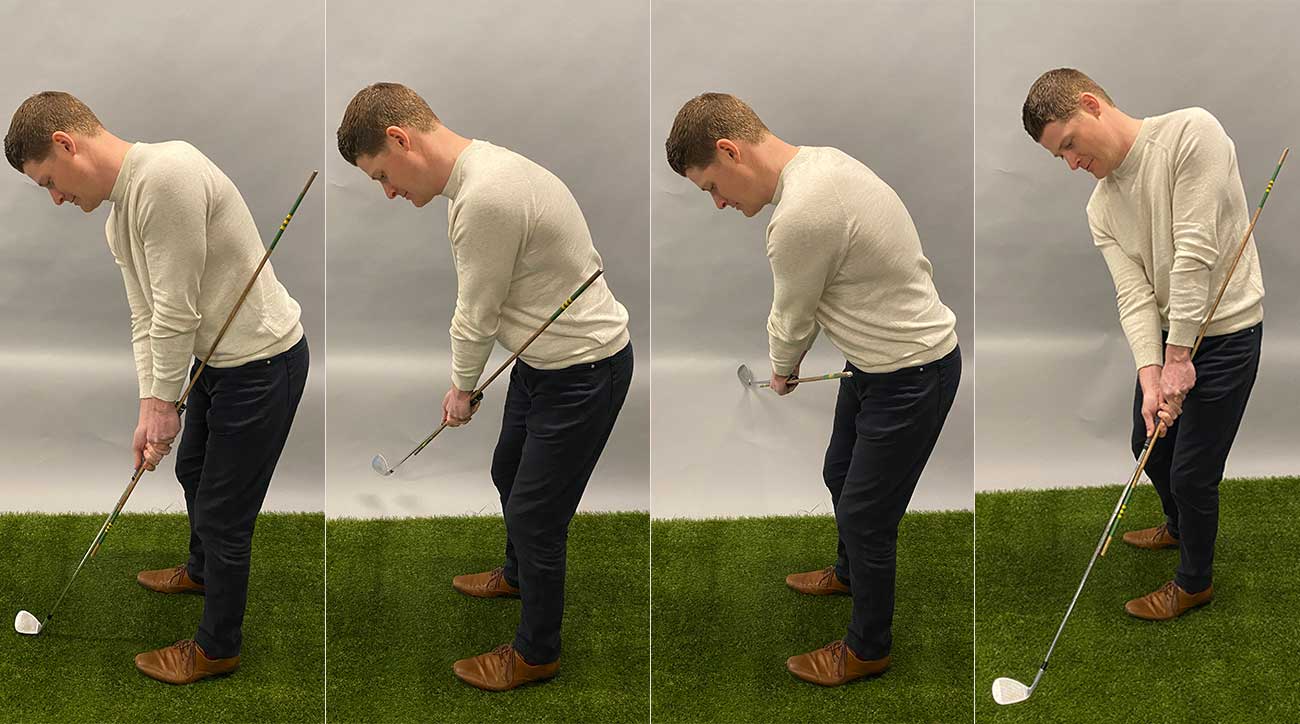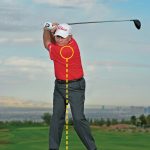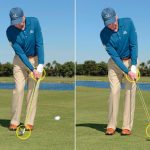To swing a chipper golf club, use a putting motion with minimal wrist action. Position the ball in the center of your stance.
A chipper golf club is designed to simplify short shots around the green. It combines features of both a putter and a wedge, making it ideal for bump-and-run shots. The club’s loft helps lift the ball slightly, while its design promotes accuracy.
Swinging a chipper requires a putting-like stroke, which minimizes complex movements. Focus on a smooth, controlled motion with limited wrist action. This technique enhances consistency and reduces mishits. Perfecting your chipper swing can significantly improve your short game, making those tricky shots around the green much easier to handle.
Introduction To Chipper Golf Clubs
Chipper golf clubs are a mix of a putter and a wedge. They help golfers with short-distance shots near the green. These clubs make it easier to chip the ball. They are especially useful for beginners.
A chipper has a loft similar to an 8 or 9-iron. But the club’s design is more like a putter. This makes it easier to control your shots. You can use it to get the ball up in the air quickly.
Benefits Of Using A Chipper
- Easy to Use: Chippers are simple for all skill levels. Even kids can use them.
- Consistent Shots: They offer more control and accuracy for short shots.
- Improves Confidence: Using a chipper can boost your confidence. You can make better shots near the green.
- Reduces Errors: Chippers reduce the chance of mistakes in short-distance shots.
When To Use A Chipper
Use a chipper when you are close to the green. It is best for shots within 30 yards. You can also use it in tricky situations. For example, when the ball is in the rough.
- Near the Green: Use a chipper for shots close to the green.
- Short Distances: Ideal for shots within 30 yards.
- Tough Spots: Useful when the ball is in the rough or a tricky spot.

Credit: www.youtube.com
Choosing The Right Chipper
Choosing the right chipper golf club can improve your short game. A chipper helps you make accurate shots near the green. Picking the right one involves understanding the types and factors affecting your choice.
Types Of Chippers
There are different types of chippers. The main ones are:
- Traditional Chippers: These have a loft similar to a 7-iron. They are easy to use for bump-and-run shots.
- Hybrid Chippers: These combine features of a putter and a wedge. They offer better control and stability.
- Two-Way Chippers: These can be used for left or right-handed shots. They are versatile but less common.
Factors To Consider
When choosing a chipper, consider these factors:
- Loft: The loft affects the ball’s flight and roll. A higher loft helps in soft landings.
- Weight: A heavier chipper provides more control. A lighter one offers better feel.
- Grip: The grip should be comfortable. It should also provide good traction.
- Shaft Length: The length affects your posture and swing. Choose a length that suits your height.
- Material: Chippers come in various materials. Stainless steel is durable, while graphite is lighter.
Choose a chipper that fits your style and needs. The right chipper can make your short game more effective.
Proper Grip Technique
Mastering the proper grip technique for a chipper golf club is crucial for your game. A good grip ensures accuracy and control. This section will guide you through the essential elements of the correct grip.
Hand Placement
Proper hand placement is the first step. Use your left hand to grip the club. Place your thumb along the shaft. Your right hand should be below the left hand. Make sure your right thumb rests on top of the shaft. Both thumbs should point down the club.
Grip Pressure
Maintaining the right grip pressure is vital. Grip the club lightly. Imagine you are holding a small bird. Too tight and you will lose control. Too loose and the club will slip.
| Grip Pressure | Outcome |
|---|---|
| Too Tight | Loss of control |
| Too Loose | Club slips |
| Just Right | Accuracy and control |
Follow these steps to achieve the perfect grip:
- Place your left hand on the club.
- Position your thumb along the shaft.
- Place your right hand below the left.
- Ensure your thumbs point down the club.
- Grip the club lightly.
By mastering these techniques, you will improve your game. Practice makes perfect, so keep trying.

Credit: golf.com
Stance And Alignment
Mastering the stance and alignment is essential for using a chipper golf club. This section will guide you through the correct feet position and body alignment. These tips will help you swing more accurately and improve your short game.
Feet Position
Start by positioning your feet shoulder-width apart. This ensures a stable base. Your weight should be evenly distributed between both feet. Bend your knees slightly. This will give you better control and balance.
Place the ball in the center of your stance. This will help you hit the ball squarely. If needed, adjust your feet slightly to ensure comfort. Comfort is key to a good swing.
Body Alignment
Align your body parallel to the target line. Your feet, hips, and shoulders should all be square. This helps maintain a straight swing path. Keep your eyes directly over the ball. This ensures better focus and accuracy.
Hold the club with a relaxed grip. Tension in your hands can ruin your swing. Make sure your arms hang naturally. This helps in executing a smooth swing.
| Aspect | Key Points |
|---|---|
| Feet Position |
|
| Body Alignment |
|
Following these tips will help you swing a chipper golf club more effectively. Proper stance and alignment are crucial for achieving accuracy and consistency in your short game.
Swing Mechanics
Mastering the swing mechanics of a chipper golf club can improve your short game. Focus on the backswing and downswing to achieve precision and control. Below, we break down each step in detail.
Backswing
The backswing sets up your swing’s foundation. Start by placing your feet shoulder-width apart. Hold the club with a light grip.
- Keep your weight balanced on both feet.
- Slowly pull the club back using your shoulders and arms.
- Ensure the clubhead stays low to the ground.
During the backswing, avoid excessive wrist movement. This helps maintain control.
Downswing
The downswing is crucial for accurate chipping. Begin by shifting your weight to the front foot.
- Keep your eyes on the ball.
- Bring the club down smoothly, leading with your hands.
- Avoid flipping your wrists; maintain a firm grip.
Finish with a controlled follow-through. Keep your body steady and your eyes focused on the target.
| Step | Key Points |
|---|---|
| Backswing | Balance weight, low clubhead, minimal wrist movement |
| Downswing | Shift weight, smooth club movement, firm grip |
Follow these steps to perfect your swing mechanics with a chipper golf club. Proper technique leads to better, more accurate shots.

Credit: www.ebay.com
Practicing Chip Shots
Practicing chip shots is essential for mastering the chipper golf club. Consistent practice improves accuracy and control on the green. Let’s explore some useful drills and common mistakes to avoid.
Drills And Exercises
Regular practice with specific drills enhances your chipping skills. Here are some effective exercises:
- Clock Drill: Place 5 balls around the hole at different distances. Aim to chip each ball into the hole.
- Gate Drill: Set two tees close to each other forming a gate. Chip the ball through the gate to improve your precision.
- Target Drill: Place a towel or target on the green. Chip the ball to land on the target, focusing on distance control.
Common Mistakes To Avoid
Avoiding common mistakes can significantly improve your chip shots. Here are some mistakes to watch out for:
- Over-gripping: Gripping the club too tightly reduces control. Use a relaxed grip for better feel.
- Improper Stance: Stand with feet too close or too far apart affects balance. Maintain a balanced, shoulder-width stance.
- Wrist Action: Excessive wrist movement can lead to inconsistency. Keep your wrists firm during the swing.
Reading The Green
Reading the green is essential for a successful chip shot. This skill helps you understand how the ball will travel. Below are key points to consider when reading the green.
Assessing The Terrain
The first step is to assess the terrain. Look for any slopes or dips. These can change the ball’s path. Take note of the grass texture. Wet grass can slow down the ball. Dry grass may speed it up. Look around for any obstacles. Rocks and twigs can alter the ball’s route.
| Terrain Feature | Impact on Ball |
|---|---|
| Slopes | Ball rolls faster downhill |
| Dips | Ball may stop or slow |
| Wet Grass | Slows down ball |
| Dry Grass | Speeds up ball |
| Obstacles | Alters ball’s path |
Predicting Ball Roll
Predicting the ball roll is the next step. Observe the slope direction. A ball will roll faster down a slope. Consider the wind speed and direction. Wind can push the ball off course. Look at the distance to the hole. A longer distance needs more force. Make a practice swing to gauge your strength. Always aim slightly higher than the hole. This helps if the ball slows down.
- Observe slope direction
- Check wind speed and direction
- Measure distance to the hole
- Make a practice swing
- Aim slightly higher than the hole
By following these steps, you can improve your chipping game. Remember, practice makes perfect. Keep reading the green, and you’ll see better results.
Advanced Techniques
Mastering advanced techniques with a chipper golf club can elevate your short game. These methods require practice but can drastically improve your performance. Below, we explore two essential advanced techniques: Bump and Run and Flop Shots.
Bump And Run
The Bump and Run is perfect for keeping the ball low. This technique allows the ball to roll towards the hole.
Here’s how to execute it:
- Stand with feet close together.
- Position the ball back in your stance.
- Use a putting-like stroke.
- Keep your wrists firm during the swing.
- Focus on a smooth follow-through.
Advantages of the Bump and Run:
| Advantage | Description |
|---|---|
| Control | Better control over the ball’s direction. |
| Consistency | Offers a consistent shot every time. |
Flop Shots
The Flop Shot is essential for high, soft landings. This shot is ideal when facing obstacles or needing a soft stop.
Steps to perform a Flop Shot:
- Open your clubface wide.
- Align your body left of the target.
- Position the ball forward in your stance.
- Use a full, relaxed swing.
- Keep your hands ahead of the clubhead.
Benefits of the Flop Shot:
- Clears obstacles easily.
- Provides soft landings on the green.
- Increases versatility around the green.
Both techniques can transform your short game. Practice them to see significant improvements in your performance.
Frequently Asked Questions
How To Use A Chipper Club In Golf?
Position the ball in the center of your stance. Use a putting stroke. Aim to make contact just like a putt.
Do Good Golfers Use Chippers?
Yes, good golfers do use chippers. Chippers help improve short game accuracy and are useful for tricky shots.
How Far Off The Green Can You Use A Chipper?
You can use a chipper from about 30 yards off the green. It provides control and accuracy for short distances.
Is A Chipper Club Legal In Golf?
A chipper club is legal in golf if it conforms to the rules set by the USGA. It must not have a putter grip or be two-sided. Always check with tournament regulations.
Conclusion
Mastering the chipper golf club can elevate your short game. Practice regularly to build confidence and precision. Remember to maintain a relaxed grip and proper stance. By following these tips, you’ll see improvements on the course. Keep refining your technique and enjoy the game.
Happy golfing!





